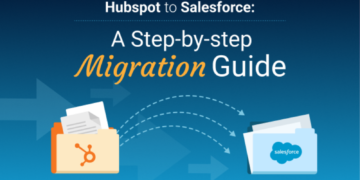
It is actually a challenging process to change one CRM system to another, but it can be made very easy and convenient to make the move with increased organization effectiveness and profitability. When trying to decide to shift from HubSpot to salesforce CRM, you are definitely not the only one. Many businesses opt to switch due to formal capabilities, high customization and scalability offered by Salesforce.
This article is a detailed, how-to guide designed to help you understand what is required Migrating from HubSpot to Salesforce and real strategies and advice for doing so successfully.
1. Why Salesforce is the Right Option?
Customer relationship management is now defined by Salesforce. It provides an array of applications for customers of all types, from individual entrepreneurs who are only starting their activity to big companies. But why should you consider migrating from HubSpot to Salesforce?
Key Advantages of Salesforce:
- Customization: Salesforce gives the ability and flexibility of choosing what the business needs from the CRM. They include features such as; drag and drop interface, custom fields, objects and custom workflows which make it possible to build a CRM solution that perfectly suits your business needs.
- Advanced Analytics & Reporting: Salesforce is particularly good at offering detailed analysis of customer information. You can establish personalized reports and help dashboards, manage sales effectiveness, and quantify essential values all in one organizational app.
- Scalability: Salesforce is a solution that scales with your company and adapts to your needs as a business expands. Pricing plans for Salesforce are affordable and flexible and can meet the needs of various sizes and types of organizations, as well as match the pace of their growth, with new users, new products, and new markets to be covered.
- Integration with Other Tools: Companies that use Salesforce can leverage the platform with third party tools such as marketing automation tools, email clients instrument, and customer support. Salesforce also has connectors but in a larger number than HubSpot provides.
- Automation: Salesforce permits for advanced workflow management, where you can directly automate some causal tasks, and streamline your approach to lead management.
2. The Ultimate Guide on How to Get Ready for Moving Data from HubSpot to Salesforce
However, before getting right down to the operational or technical part of migration, one should ensure that the groundwork is well done. Here are some key preparation steps to take before you move your data from HubSpot to Salesforce:
1. Define Your Migration Goals
- Begin with the end in mind and learn what you intend to accomplish with migration. That’s why patenting a business method could be more advantageous than patenting a physical invention: Is it to improve the reporting function? Improve automation? Ensure better data security? Goal setting will therefore assist in the decision-making process all through the process.
2. Evaluate Your Data
- If you have a HubSpot account, then audit your data very carefully. Knowing what kind of data must be transferred is an important first step – contacts, companies, deals, and notes, for instance. Check what data is to be migrated in detail and whether there is any stale information that requires ‘cleaning’ before migrating into the new system.
3. Map Data Points from HubSpot to Salesforce
- One of the strategic success factors of any CRM migration is data mapping. All this means that using mapped data in reports you will have to interpret how HubSpot’s data structure translates to that of Salesforce. For instance, like HubSpot’s “Deals”, it might be identical to Salesforce’s “Opportunities”. Recruit mapping of fields of both interfaces so that nothing important is left out.
4. Choosing what Edition of Salesforce for your business could be a tricky task so here are some tips for you
- Known marks are different editions that provide more or less functionality to the users. Make sure that you choose one edition that is suitable for your business. However, if you are a small businessperson, you may find that the Salesforce Essentials edition will be adequate. Salesforce may need to offer a Salesforce Professional, Enterprise or Developer edition to larger organizations.
5. Overview of the Plan on Data Security and Compliance
- Data security is incredibly important and specifically when transferring prospects’ data that might be personal. Make sure the migration journey does not violate a regulation such as GDPR or CCPA and get to know if Salesforce’s security procedures are satisfactory for your business.
6. Test the Migration Process
- When planning the actual switch, begin with a limited trial of your migration process with a small sample data. This will assist in finding nefarious problems and make certain everything works.
3. HubSpot vs. Salesforce: A Growth-Focused Comparison
It is significant to take a moment and estimate how the main benefits of HubSpot and Salesforce operate to determine whether the migration will pursue the growth goals.
1. Ease of Use
- It is easy to use, and most of the features offer no need for technical input when it comes to implementation. As such, it is suitable for small businesses or groups with little-to-no CRM experience to give a bonus for entrepreneurs. Whereas Salesforce is relatively harder to learn and implement but provides a scope of far higher customization and flexibility.
2. Customization & Flexibility
- Comparing the options for customization, HubSpot has some ability to do it whereas Salesforce probably has no equals. It makes it possible for businesses to define objects, fields, reports, and dashboards that meet their unique needs. When it comes to the choice of the company and its specific form of work, Salesforce is the best tool in terms of the implementation of CRM for the company.
3. Automation Capabilities
- Salesforce has an advanced automation feature where you can customize your tasks and automate complicated work. The approach that HubSpot uses is much simpler but in our opinion does not offer as much as Salesforce does and might not be enough for complex enterprises or for businesses that are very developed.
4. Pricing
- HubSpot is often even cheaper, unless the company requires the full-fledged CRM system with all its potential. But Salesforce pricing is little different with lots of plans and options and add-ons, yet it’s still one of the best CRM investments for ambitious organizations.
5. Support and Resources
- Salesforce offers lots of support, training and resources, as is the case for its Salesforce Trailhead learning platform. HubSpot also has well developed support, but it may not be as detailed as in the case with more elaborate tools and their integration.
4. HubSpot to Salesforce: Step-by-Step
We are now ready to proceed with the real migration process. Here’s a step-by-step breakdown of the process:
1. Backup Your HubSpot Data
- Before migration, you should probably copy the data from HubSpot. This serves as backup in case there is a hitch during the migration process.
2. Set Up Salesforce
- Introduce the aspects of an implementation project according to the selected edition of Salesforce as well as the possible changes referred to your organization’s needs. Set up orgs, users, profiles, layouts, roles, and permissions so that your Salesforce organization emulates your business processes.
3. A migration tool/migration service is used
- There are different data import tools available at Salesforce including Data Import Wizard and Data Loader. However, you can avoid redoing everything by using third-party tools or migration service that will help establish a proper integration between HubSpot and Salesforce. These tools assist in the process of helping minimize time spent and to assist in avoiding individuals’ errors.
4. Migrate Data
- Start migrating your data by focusing on the basic records those include contacts, companies, deals, notes, etc. This is done automatically by the service provider if you are using the migration service. As a recommendation make sure that all the required fields are mapped so that no field is left behind in the migration process.
5. Test the Migration
- After migration of data do a quick sanity check of the complete system to verify that all records, reports as well as workflows are working as they are supposed to. Verify the lack of missing data keys and then compare the structure of different columns from both databases and solve all the problems before completing the migration.
6. Train Your Team
- When they have relocated, it is vigorously advised that you educate your team how capable Salesforce is of serving them. It has a vast training domain where your team members can learn about different aspects of Salesforce quickly.
7. Go Live
- Finally, when everything has been organized and checked, launch Salesforce to be used in your business. It is absolutely critical for any new system to be watched during the first few weeks, especially to see if there are any problems which have gone unnoticed that your team can handle so that you can correct them appropriately.
Conclusion
It must be clear that transitioning from HubSpot to Salesforce is undoubtedly possible, but how can it be done correctly to make this process not a problem but a vast field of new opportunities for your business? Over the years, Salesforce has been known for its customization, proven automation capabilities, and flexibility in scaling-up. Knowledge of these strengths will further the growth of the business.
Each step is critical and starts with setting objectives and assessing the data to be migrated, passing through the selection of the right Salesforce edition, and finishing with data protection. It is also important to get beforehand experience of migration prior to large-scale implementation to identify such problems.
In the end, the change from HubSpot to Salesforce is not just shifting from one database to another; it is migrating from one system to another with an incredibly strong CRM front that will help to build stronger customer relations, increase productivity and ensure sustained growth. If effectively planned and implemented, this migration does more than consolidate your business processes; it creates a foundation for further growth and success in today’s business world.
That is why following the steps described and realizing the potential of Salesforce will allow anyone to have a smooth transition and become a beneficiary of the change through implementing this leading CRM solution.
























































